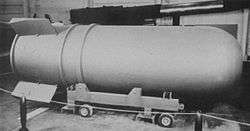B41 nuclear bomb

The B-41 (also known as Mk-41) was a thermonuclear weapon deployed by the United States Strategic Air Command in the early 1960s. It was the most powerful nuclear bomb ever developed by the United States, with a maximum yield of 25 megatons. The B-41 was the only three-stage thermonuclear weapon fielded by the U.S.[1]
Development
The development of the B-41 began in 1955 with a USAF requirement for a Class B (high-yield, over 10,000 lb or 4,500 kg) weapon. It was based on the "Fagotti (bassoon)" test device first fired in the Redwing Zuni test of 27 May 1956. An ICBM warhead version of the weapon was cancelled in 1957 while still in the design stage.
Composition
The B-41 was the only three-stage thermonuclear weapon fielded by the U.S. It had a deuterium-tritium boosted primary, probably with lithium-6-enriched deuteride fuel for the fusion reaction in the secondary stage. This was followed by a yet-larger third fusion stage, the tertiary stage, compressed by the secondary stage. Finally, there was a fission jacket.
Two versions were deployed, Y1, a "dirty" version with a tertiary stage encased with U-238 (natural uranium), and Y2, a "clean" version with a lead-encased tertiary. It was the highest-yield nuclear weapon ever deployed by the United States, with a maximum yield of 25 megatons (Mt), and weighing in at 4,850 kg (10,690 lb). It remains the highest yield-to-weight ratio of any weapon created. The US claimed in 1963 that it could produce a 35 Mt fusion bomb, and put it on a Titan II (3,700 kg [8,200 lb] payload), almost doubling the yield-to-weight ratio of the B-41.
The B-41 was of the usual long cylindrical shape. The nuclear fusion warhead was of the Teller-Ulam type and used a 40–100 kiloton implosion type nuclear fission primary (reportedly based on the Smokey TX-41 shot of Operation Plumbbob)[2] fueled by HEU to trigger the lithium-6 deuteride fusion fuel. Between 500 and 1,000 kg (1,100 and 2,200 lb) of lithium deuteride was used and, in the Y1 version, the third ("tertiary") stage was enclosed in a uranium tamper.[1]
The B-41 was an example of a fission-fusion-fusion-fission type thermonuclear weapon, or tertiary stage bomb. The additional tertiary fusion stage, compressed by a previous fusion stage, could be used to make a bomb with yields as large as desired (see Tsar Bomba, a Soviet three-stage bomb and the highest-yield nuclear weapon ever built or tested).
Physical characteristics
The weapon was 12 ft 4 in (3.76 m) long, with a body diameter of 4 ft 4 in (1.32 m). It weighed 10,670 lb (4,840 kg). It was carried only by the B-52 Stratofortress and B-47 Stratojet. It could be deployed in free-fall or aerial (parachute) configuration, and could be set for airburst, groundburst, or laydown delivery.
Service life
The B-41 (designated Mk-41 until 1968) entered service in 1961. About 500 of these weapons were manufactured between September 1960 and June 1962. The B-41 was progressively phased out of service beginning in 1963, superseded by the B53 nuclear bomb. The last B-41s were retired in July 1976.
Efficiency
During its operation, the B-41 was the most efficient known thermonuclear weapon in terms of yield to actual weight, with a 5.2 Megaton/tonne ratio (based on a 25 Mt yield). Its blast yield was 25 to 50% that of the AN602 Tsar Bomba, which delivered a blast of 50 or 100 megatons of TNT, depending on its own configuration as a "clean" (lead encased) or dirty (uranium encased) bomb. However even at the Tsar Bomba's theoretical maximum yield of 100 megatons, it would still only achieve a yield to weight ratio of ~ 3.7 Megaton/tonne, thus the B-41 is the most efficient, highest yield to weight ratio, weapon ever created.[3][2] However, since neither full yield versions of the B-41 nor "Tsar Bomba" were ever demonstrably tested, the B-41's high efficiency is merely theoretical; the most efficient tested and proven nuclear physics package is the W56.
Effects
If detonated at optimal height, the B-41 would generate a fireball approximately 4 miles (6.4 km) in diameter, it would have been able to destroy reinforced concrete buildings 8 miles (13 km) from ground zero, and it would have been able to destroy most residential structures 15 miles (24 km) from ground zero, while producing third degree burns 32 miles (51 km) from ground zero.
In the case of a surface burst, the fallout's maximum downwind cloud distance could possibly reach 658 miles (1,059 km) from ground zero.
See also
References
- 1 2 "The B-41 (Mk-41) Bomb" Nuclear Weapon Archive. (accessed April 8, 2015).
- 1 2 Carey Sublette, "Operation Plumbbob," Nuclear Weapon Archive, http://nuclearweaponarchive.org/Usa/Tests/Plumbob.html. (accessed December 27, 2006).
- ↑ The B-41 was ...the most efficient bomb or warhead actually deployed by any country during the Cold War and afterwards. http://www.ieri.be/fr/publications/ierinews/2011/juillet/fission-fusion-and-staging.